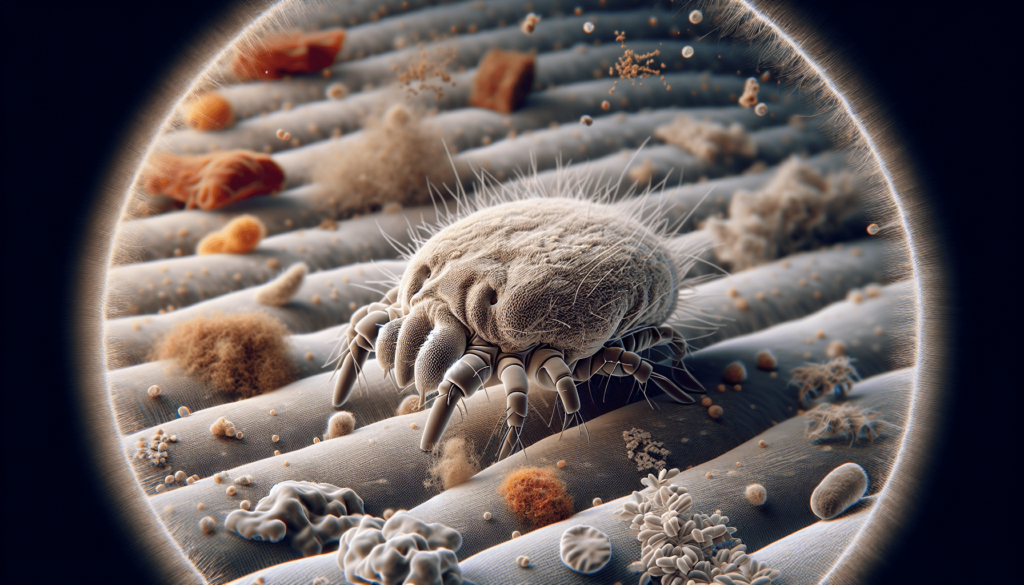Identifying and Managing Common Allergens in Your Living Space” offers invaluable insights into creating a healthier home environment. As you navigate your living space, you’ll uncover various allergens that could be triggering discomfort or health issues for you and your loved ones. From dust mites nestled in your carpets to mold lurking in the damp corners of your bathroom, this guide helps you recognize and effectively manage these common culprits. By the end, you’ll be equipped with practical tips and strategies to reduce allergens and foster a cleaner, more comfortable home. Have you ever wondered why you or your family members seem to sneeze more often at home, especially at certain times of the year? Understanding and managing allergens in your living space can greatly enhance your quality of life. This article aims to guide you through identifying and controlling the most common allergens found in your home, helping you create a more comfortable and healthier living environment.

What Are Allergens?
Allergens are substances that can provoke an allergic reaction in some individuals. These reactions occur when the body’s immune system mistakenly identifies a usually harmless substance as a threat. Common symptoms include sneezing, itching, runny nose, and in more severe cases, difficulty breathing.
Why Identifying Allergens Is Important
Identifying the specific allergens in your living space is crucial for effective management and treatment. Misidentification can lead to the persistence of symptoms, which can significantly affect daily activities and overall well-being. By pinpointing the culprits, you can make more informed decisions about reducing exposure and mitigating symptoms.
Common Allergens Found in Living Spaces
Allergens can come from various sources. Here, we’ll explore some of the most frequently encountered:
Dust Mites
Dust mites are microscopic arachnids that thrive in household dust. They are a common cause of indoor allergies and are found in bedding, upholstery, and carpet.
| Fact | Details |
|---|---|
| Size | Microscopic (0.2-0.3 mm) |
| Habitat | Warm, humid environments; mattresses, pillows, carpets |
| Prevention | Regular washing and vacuuming, use of allergen-proof covers |
Pet Dander
Pet dander consists of tiny flecks of skin shed by animals with fur or feathers. These particles can trigger allergies in sensitive individuals.
| Fact | Details |
|---|---|
| Common Pets | Cats, dogs, birds |
| Allergic Component | Proteins in skin flakes, saliva, urine |
| Prevention | Regular grooming, limiting pet access to bedrooms |
Mold
Mold spores are another common household allergen. Mold thrives in damp, humid conditions and can be found in bathrooms, kitchens, and basements.
| Fact | Details |
|---|---|
| Habitat | Areas with high humidity; bathrooms, basements, kitchens |
| Symptoms | Sneezing, coughing, wheezing, itchy eyes |
| Prevention | Use of dehumidifiers, proper ventilation, regular cleaning |
Pollen
While pollen is more commonly associated with outdoor allergies, it can enter the home through windows, doors, and vents.
| Fact | Details |
|---|---|
| Sources | Trees, grasses, weeds |
| Peak Seasons | Spring, summer, and fall |
| Prevention | Keeping windows closed during high pollen seasons, using air purifiers |
Cockroach Droppings
Cockroach droppings and body parts can be potent allergens, often found in areas where food is prepared and stored.
| Fact | Details |
|---|---|
| Common Locations | Kitchens, bathrooms, basements |
| Prevention | Regular cleaning, sealing cracks, using bait or traps |
Chemical Irritants
Household products such as cleaning agents, air fresheners, and paints can emit volatile organic compounds (VOCs) that can provoke allergic reactions.
| Fact | Details |
|---|---|
| Common Products | Cleaners, paints, air fresheners |
| Symptoms | Headaches, eye/throat irritation, dizziness |
| Prevention | Using natural or VOC-free products, ensuring proper ventilation |
Identifying Allergens in Your Home
Identifying the specific allergens in your home requires a bit of detective work. Here are some steps you can take:
Allergy Testing
Consult an allergist to undergo allergy testing, which could include skin prick tests or blood tests. This professional insight will help you identify specific allergens you need to address.
Observing Symptoms
Keep a diary to track when and where allergy symptoms occur. Note the time of day, the season, and any specific activities that might be linked to your symptoms.
Home Inspection
Carry out a thorough inspection of your home to identify potential allergen sources. Look in areas that tend to accumulate dust, retain moisture, or be frequented by pets.
Managing Dust Mites
Managing dust mites involves multiple strategies aimed at reducing their presence and minimizing your exposure.
Bedding
Wash bedding, including sheets, pillowcases, and blankets, in hot water (at least 130°F) once a week. Consider using allergen-proof covers for pillows and mattresses.
Cleaning and Vacuuming
Vacuum carpets and upholstered furniture regularly with a vacuum cleaner that has a HEPA filter. Dust surfaces with a damp cloth to trap and remove dust rather than dispersing it into the air.
Humidity Control
Since dust mites thrive in humid conditions, maintaining indoor humidity levels below 50% can help reduce their numbers. Use dehumidifiers and air conditioners to manage humidity.
Controlling Pet Dander
If you have pets, managing their dander is vital to reducing allergens in your home.
Grooming
Regular grooming can significantly reduce the amount of dander your pet sheds. Bathe your pets frequently and brush them outside to minimize indoor dander accumulation.
Cleaning
Vacuum frequently, especially in areas where your pet likes to sleep. Consider using a vacuum cleaner with a HEPA filter to capture smaller particles. Wash pet bedding regularly.
Restricted Areas
Keep pets out of bedrooms and off furniture as much as possible. Designate specific pet-free zones in your home to reduce overall dander exposure.

Managing Mold
Controlling mold involves moisture control, physical cleaning, and preventive measures.
Moisture Control
Use dehumidifiers to keep indoor humidity levels between 30-50%. Ensure proper ventilation in moisture-prone areas like bathrooms and kitchens by using exhaust fans or opening windows.
Cleaning
Clean mold-prone areas regularly with mold-killing products. Be sure to wear protective gear, such as gloves and masks, to minimize exposure.
Inspect and Repair
Regularly inspect your home for leaks, and repair them promptly. Ensure that gutters and downspouts direct water away from your home’s foundation.
Reducing Pollen Exposure
Keeping pollen out of your home can be challenging during peak seasons, but it’s manageable with some creative strategies.
Windows and Doors
Keep windows and doors closed during high pollen seasons. Use air conditioning to cool your home rather than natural ventilation.
Air Purifiers
Use air purifiers equipped with HEPA filters to capture pollen that may enter your home. Place them in bedrooms and living areas for the best results.
Outdoor Gear
Change clothes and shower after spending extended periods outside to remove pollen from your body. Avoid drying clothes outside during high pollen seasons.
Managing Cockroach Droppings
Keeping cockroaches at bay is essential for maintaining a healthy home environment.
Cleanliness
Maintain a clean kitchen by promptly cleaning up food spills and crumbs. Store food in airtight containers and dispose of garbage regularly.
Sealing Entry Points
Seal cracks and crevices around your home to prevent cockroaches from entering. Focus on gaps around windows, doors, and pipes.
Pest Control
Consider professional pest control services to effectively manage and eliminate cockroach infestations. Use traps and baits as additional measures.
Minimizing Chemical Irritants
Reducing exposure to chemical irritants involves mindful product choices and adequate ventilation.
Product Choice
Opt for natural or organic cleaning products, and avoid those that contain harsh chemicals. Look for VOC-free paints and finishings.
Ventilation
Ensure your home is well-ventilated when using products that emit fumes. Use exhaust fans, open windows, and consider using air purifiers.
Storage
Store chemicals, cleaning products, and paints in tightly sealed containers and in well-ventilated areas, away from living spaces.
Lifestyle Changes and Additional Tips
Making a few lifestyle changes can also help manage allergens effectively.
Smoking
Do not smoke indoors. Tobacco smoke can exacerbate respiratory allergies and introduce additional irritants.
Minimalism
Reduce clutter in your home to minimize dust accumulation. Simpler, clutter-free spaces are easier to clean and maintain.
Regular Maintenance
Schedule regular maintenance tasks, such as HVAC filter replacements and chimney cleaning, to ensure your home remains allergen-free.
When to Seek Professional Help
While self-management strategies can significantly reduce allergens, sometimes professional help is necessary. Consider consulting professionals in the following scenarios:
Persistent Symptoms
If you’ve taken steps to manage allergens and still experience persistent symptoms, consult an allergist for advanced treatment options.
Severe Allergies
For severe allergies or asthma, medical intervention is crucial. Discuss allergy medications or immunotherapy with your healthcare provider.
Home Inspection Services
Professional home inspection services can identify hidden allergens and recommend effective mitigation strategies. This can include mold inspections, pest control assessments, and indoor air quality evaluations.
Conclusion
Managing allergens in your living space requires a consistent and comprehensive approach. By identifying the common allergens affecting your home and adopting targeted management strategies, you can create a healthier environment for you and your loved ones. Remember, small changes can make a big difference in alleviating allergy symptoms and improving quality of life. Stay proactive, and your home can become a sanctuary free from allergens.
